The start, Stop, Continue example framework is a powerful tool that helps teams and individuals reflect on their actions, identify areas for improvement, and celebrate successes. In this guide, we will explore practical examples of Start, Stop, Continue feedback, delve into its application for managers, and provide a comprehensive approach to implementing this framework within your organization. By the end, you'll have the insights needed to harness this technique for enhancing team performance and achieving your business goals.
What are Good Start Stop, Continue Examples?

The Start, Stop, Continue framework is an effective method for structured feedback that promotes positive change and continuous improvement. Let's break down each component with practical examples:
Start
The "Start" component encourages individuals or teams to initiate new actions or behaviors that could lead to improved performance or better outcomes. Here are a few start, stop, continue examples:
Start Regular Team Meetings: Begin holding weekly team meetings to enhance communication and ensure everyone is aligned on goals and progress.
Stop
The "Stop" component focuses on identifying and discontinuing actions or behaviors that are unproductive or harmful to the team's progress. Here are some examples:
Stop Holding Unnecessary Meetings: Eliminate meetings that don't add value and waste time.
Stop Ignoring Work-Life Balance: Address the tendency to overwork and encourage a healthier work-life balance for better productivity and morale.
Continue
The "Continue" component highlights the actions and behaviors that are effective and should be maintained. Here are some examples:
Continue Providing Professional Development Opportunities: Sustain efforts to offer training and growth opportunities to enhance skills and career progression.
Start Stop, Continue Examples
Start Stop, Continue Examples for Manager
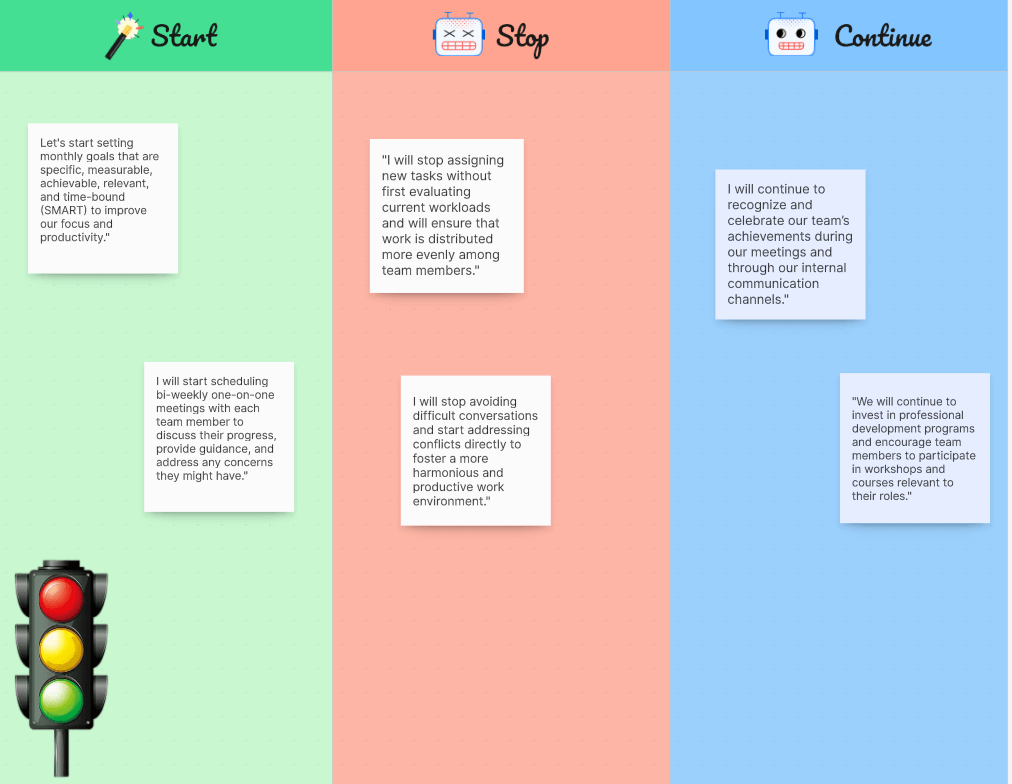
Start
Start Setting Clear Goals: Begin defining clear, measurable objectives for the team. This helps provide direction and aligns efforts toward common goals.
Example: "Let's start setting monthly goals that are specific, measurable, achievable, relevant, and time-bound (SMART) to improve our focus and productivity."
Start Holding One-on-One Meetings: Initiate regular one-on-one meetings with team members to understand their challenges, provide personalized feedback, and support their growth.
Example: "I will start scheduling bi-weekly one-on-one meetings with each team member to discuss their progress, provide guidance, and address any concerns they might have."
Stop
Stop Providing Vague Feedback: Avoid giving non-specific feedback that doesn't offer clear guidance on how to improve.
Example: "Stop Providing Vague Feedback
Stop Overloading Team Members: Recognize the importance of a balanced workload and avoid assigning too many tasks to individuals.
Example: "I will stop assigning new tasks without first evaluating current workloads and will ensure that work is distributed more evenly among team members."
Stop Ignoring Conflict: Address conflicts directly and constructively rather than ignoring them, which can lead to unresolved issues and decreased team morale.
Example: "I will stop avoiding difficult conversations and start addressing conflicts directly to foster a more harmonious and productive work environment."
Continue
Continue Recognizing Team Efforts: Maintain the practice of acknowledging and rewarding team efforts and successes.
Example: "I will continue to recognize and celebrate our team’s achievements during our meetings and through our internal communication channels."
Continue Providing Learning Opportunities: Keep offering training and development opportunities to help team members enhance their skills and advance their careers.
Example: "We will continue to invest in professional development programs and encourage team members to participate in workshops and courses relevant to their roles."
Start Stop, Continue Examples for Teams
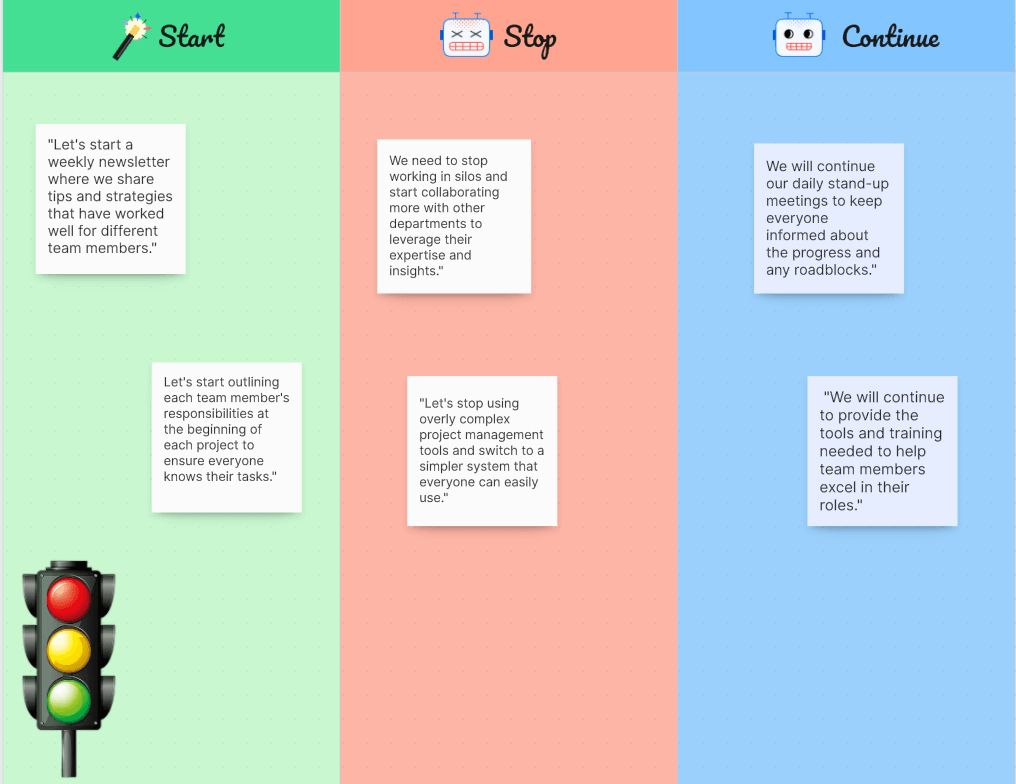
Start
Start Sharing Best Practices: Begin sharing best practices and success stories within the team to promote learning and improvement.
Example: "Let's start a weekly newsletter where we share tips and strategies that have worked well for different team members."
Start Setting Clear Roles and Responsibilities: Define and communicate clear roles and responsibilities to avoid confusion and ensure accountability.
Example: "Let's start outlining each team member's responsibilities at the beginning of each project to ensure everyone knows their tasks."
Stop
Stop Working in Silos: Eliminate the practice of working in isolation and encourage cross-functional collaboration.
Example: "We need to stop working in silos and start collaborating more with other departments to leverage their expertise and insights."
Stop Overcomplicating Processes: Simplify processes and procedures to reduce inefficiencies and streamline workflows.
Example: "Let's stop using overly complex project management tools and switch to a simpler system that everyone can easily use."
Continue
Continue Regular Check-Ins: Maintain regular check-ins and status updates to ensure everyone is on track and issues are addressed promptly.
Example: "We will continue our daily stand-up meetings to keep everyone informed about the progress and any roadblocks."
Continue Providing Support and Resources: Ensure the team has the necessary support and resources to perform their tasks effectively.
Example: "We will continue to provide the tools and training needed to help team members excel in their roles."
Start, Stop, Continue Examples for Colleagues
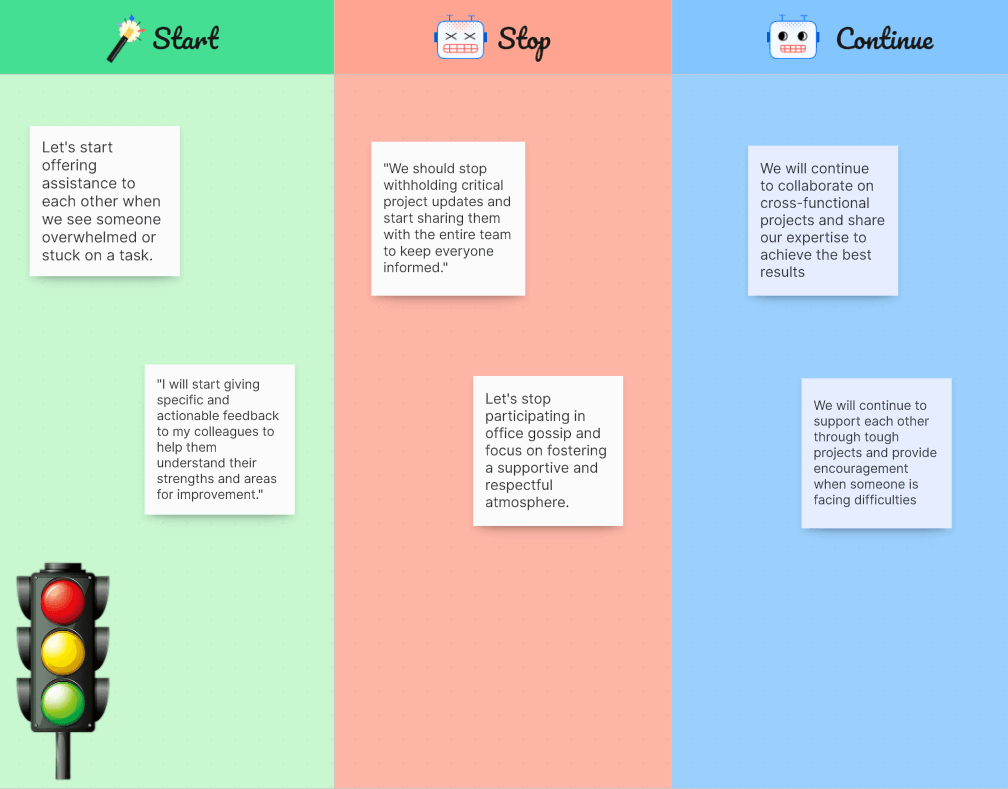
Start
Start Offering Help: Begin offering help and support to colleagues who may be struggling with their tasks.
Example: "Let's start offering assistance to each other when we see someone overwhelmed or stuck on a task."
Start Giving Constructive Feedback: Provide constructive feedback to help colleagues improve their performance and skills.
Example: "I will start giving specific and actionable feedback to my colleagues to help them understand their strengths and areas for improvement."
Stop
Stop Withholding Information: Avoid keeping important information to yourself and ensure it is shared with those who need it.
Example: "We should stop withholding critical project updates and start sharing them with the entire team to keep everyone informed."
Stop Engaging in Gossip: Eliminate gossip and negative talk about colleagues to maintain a positive and professional work environment.
Example: "Let's stop participating in office gossip and focus on fostering a supportive and respectful atmosphere."
Continue
Continue Collaborating: Maintain a collaborative spirit by working together on projects and sharing knowledge and resources.
Example: "We will continue to collaborate on cross-functional projects and share our expertise to achieve the best results."
Continue Supporting Each Other: Keep providing emotional and professional support to colleagues, especially during challenging times.
Example: "We will continue to support each other through tough projects and provide encouragement when someone is facing difficulties."
Start, Stop, Continue Examples for Your Boss
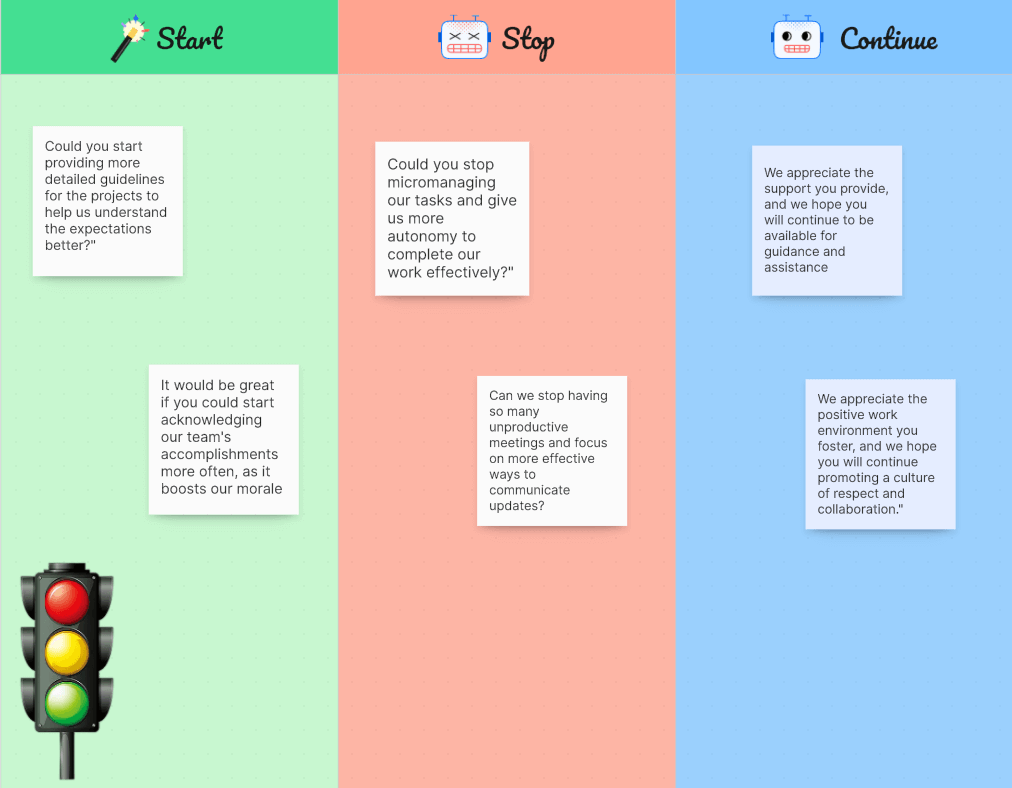
Start
Start Providing Clear Instructions: Request that your boss gives more detailed and clear instructions for tasks and projects.
Example: "Could you start providing more detailed guidelines for the projects to help us understand the expectations better?"
Start Giving More Recognition: Encourage your boss to recognize and appreciate the efforts and achievements of the team more frequently.
Example: "It would be great if you could start acknowledging our team's accomplishments more often, as it boosts our morale."
Stop
Stop Micromanaging: Request your boss to trust the team with their responsibilities and avoid excessive oversight.
Example: "Could you stop micromanaging our tasks and give us more autonomy to complete our work effectively?"
Stop Holding Unproductive Meetings: Suggest reducing the number of unnecessary meetings that don't add value to your work.
Example: "Can we stop having so many unproductive meetings and focus on more effective ways to communicate updates?"
Continue
Continue Providing Support: Acknowledge and appreciate the support your boss provides and encourage them to keep doing so.
Example: "We appreciate the support you provide, and we hope you will continue to be available for guidance and assistance."
Continue Fostering a Positive Work Environment: Appreciate the positive work environment your boss creates and encourage them to continue.
Example: "We appreciate the positive work environment you foster, and we hope you will continue promoting a culture of respect and collaboration."
Start, Stop, Continue Examples for Work

Start
Start Implementing Agile Practices: Begin incorporating Agile methodologies to improve project management and delivery.
Example: "Let's start using Agile practices like sprints and daily stand-ups to enhance our project management and productivity."
Start Promoting Work-Life Balance: Encourage practices that promote a healthy work-life balance for employees.
Example: "We should start promoting work-life balance by offering flexible work hours and encouraging employees to take breaks and vacations."
Stop
Stop Relying on Outdated Technology: Phase out old technology and invest in modern tools that improve efficiency and productivity.
Example: "We need to stop relying on outdated software and start investing in modern tools that can streamline our processes."
Stop Tolerating Poor Performance: Address performance issues promptly and provide the necessary support for improvement.
Example: "Let's stop tolerating consistent underperformance and start implementing performance improvement plans to support growth."
Continue
Continue Innovating: Maintain the focus on innovation and encourage creative solutions to business challenges.
Example: "We will continue to prioritize innovation and support initiatives that bring new and creative solutions to our challenges."
Continue Investing in Employee Development: Keep investing in the growth and development of employees through training and career advancement programs.
Example: "We will continue to invest in our employees' development by offering training programs and opportunities for career advancement."
Implementing Start, Stop, Continue Feedback in Your Organization
Successfully implementing the Start, Stop, Continue framework in your organization involves several steps to ensure it is adopted effectively and yields positive results. Here’s a detailed guide:
Step 1: Introduce the Concept
Educate your team about the Start, Stop, Continue framework, explaining its purpose and benefits. Highlight how it can help improve individual and team performance through structured feedback.
Communication: Use meetings, emails, or internal memos to introduce the concept.
Training: Conduct workshops or training sessions to familiarize team members with the framework and how to use it effectively.
Step 2: Set Clear Expectations
Define the expectations for providing and receiving feedback using the Start, Stop, Continue method. Ensure everyone understands the importance of constructive and respectful feedback.
Guidelines: Develop guidelines on how to give and receive feedback constructively.
Examples: Provide examples of effective Start, Stop, Continue feedback to illustrate the desired approach.
Step 3: Create a Safe Environment
Foster a culture of trust and openness where team members feel safe to share their thoughts without fear of retribution or judgment.
Psychological Safety: Encourage open dialogue and emphasize that feedback is aimed at improvement, not criticism.
Confidentiality: Assure team members that their feedback will be handled confidentially if they prefer.
Step 4: Schedule Regular Feedback Sessions
Integrate Start, Stop, Continue feedback into your regular routines, such as team meetings, project reviews, or performance evaluations.
Consistency: Schedule regular feedback sessions to make the process routine and expected.
Integration: Incorporate the framework into existing performance review processes and meeting agendas.
Step 5: Encourage Participation
Motivate all team members to participate actively in giving and receiving feedback. Emphasize that everyone’s input is valuable and contributes to the overall success of the team.
Incentives: Recognize and reward participation to encourage engagement.
Support: Provide support and resources to help team members feel confident in giving feedback.
Step 6: Act on Feedback
Demonstrate a commitment to continuous improvement by taking action based on the feedback received. Show that feedback is valued and leads to tangible changes.
Follow-Up: Regularly follow up on the feedback given to show progress and address any ongoing concerns.
Transparency: Communicate the actions taken in response to feedback to the team.
Step 7: Review and Refine
Periodically review the effectiveness of the Start, Stop, Continue framework in your organization. Gather feedback on the process itself and make adjustments as needed.
Evaluation: Assess the impact of the feedback on team performance and morale.
Adjustments: Refine the process based on feedback to ensure it remains effective and relevant.
Implementing Start, Stop, Continue with Boardmix
Using tools like Boardmix can enhance the implementation of the Start, Stop, Continue framework. Boardmix offers a collaborative platform where teams can easily share and organize feedback. Here’s how to do it:
Create a New Board: Start by creating a new board on Boardmix for your team’s feedback sessions.
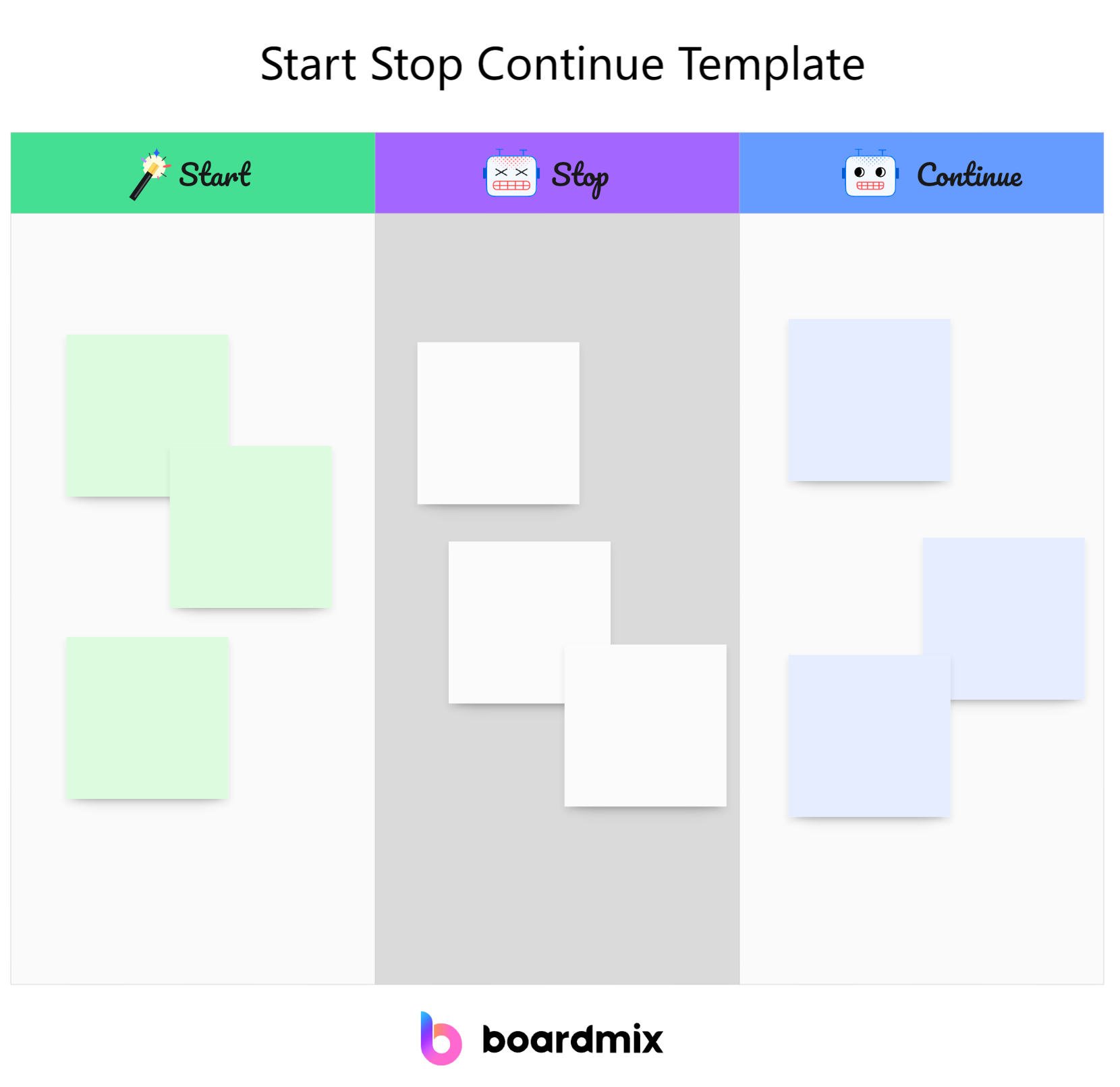
Set Up Columns: Divide the board into three columns: Start, Stop, and Continue.
Add Feedback: Encourage team members to add their feedback under the respective columns. They can use sticky notes, text boxes, or other tools available on Boardmix.
Collaborate in Real-Time: Use Boardmix’s real-time collaboration features to discuss feedback during meetings and make collective decisions.
Track Progress: Keep the board updated with actions taken in response to feedback. This helps track progress and ensures accountability.
FAQ
How can Start, Stop, Continue improve team performance?
The framework encourages structured feedback, promoting positive change and continuous improvement. It helps teams identify what works, what doesn’t, and what new actions can enhance performance, leading to better outcomes and a more cohesive team.
How often should Start, Stop, Continue feedback be given?
The frequency can vary based on the needs of the team or organization. Regular feedback sessions, such as monthly or quarterly, are recommended to maintain continuous improvement and address issues promptly.
Can Start, Stop, Continue be used for personal development?
Yes, Start, Stop, Continue is an effective tool for personal development. Individuals can use it to reflect on their actions, identify areas for growth, and make informed decisions about their behavior and performance.
What are some common challenges in implementing Start, Stop, Continue?
Common challenges include resistance to feedback, lack of participation, and ineffective communication. Overcoming these challenges requires fostering a culture of trust, providing clear guidelines, and encouraging active participation from all team members.
The Start, Stop, Continue framework is a powerful tool for driving continuous improvement and enhancing team performance. By providing structured feedback, teams can identify what works, what needs to change, and what new actions can lead to better outcomes. Implementing this framework requires clear communication, a supportive environment, and a commitment to acting on feedback. Tools like Boardmix can facilitate the process, making it easier to organize and collaborate on feedback. Embrace the Start, Stop, Continue framework to foster a culture of continuous improvement and achieve greater success within your organization.








